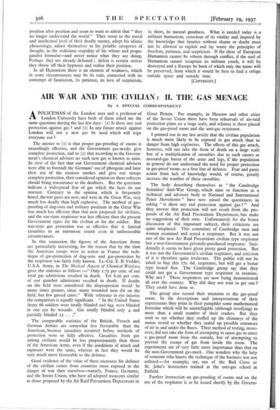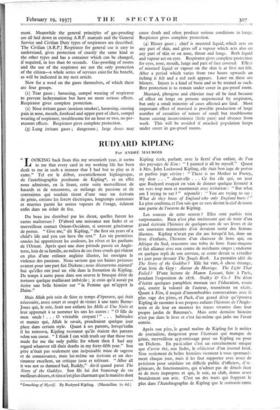AIR WAR AND THE CIVILIAN: II. THE GAS MENACE
By A SPECIAL CORRESPONDENT
APOLICEMAN of the London area and a professor of London University have both of them asked me the same questions during the last few days : (t) Is there any real protection against gas ? and (2) In any future attack against London will not a new gas be used which will wipe everyone out ?
The answer to (r) is that proper gas-proofing of rooms is exceedingly effective, and the Government gas-masks give complete protection, and to (2) that according to the Govern- ment's chemical advisers no such new gas is known to exist. In view of the fact that our Government chemical advisers were able to forestall the Germans' use of phosgene and later their use of the noxious smokes and give our troops complete protection, their considered opinion on these subjects should bring reassurance to the doubters. But the questions indicate a widespread fear of gas which the facts do not warrant. Contrary to the opinion which is frequently heard, the war gases are now, and were in the Great War, very much less deadly than high explosive. The method of gas- proofing of dug-outs and military positions in the Great War was much less efficient than that now proposed for civilians, and the war-time respirator was less efficient than the present Government types for the civilian or for the soldier. But war-time gas protection was so effective that it limited casualties to an enormous extent even in unfavourable circumstances.
In this connexion the figures of the American Army are particularly interesting, for the reason that by the time the American troops were in action in France the tech- nique of gas-protection of dug-outs and gas-protection by the respirator was fairly fully known. Lt.-Col. E. B. Vedder, U.S.A. Army, in The Medical Aspects of Chemical Warfare, gives the statistics as follows :—" Only 1.73 per cent. of our total gas admissions resulted in death. Yet 8.26 per cent. of our gunshot admissions resulted in death. If deaths on the field were considered the disproportion would be many times greater, since many wounded men die on the field, but few gassed cases." With reference to eye injuries the comparison is equally significant. "In the United States Army 66 soldiers were totally blinded and 644 were blinded in one eye by wounds. Gas totally blinded only 4 and partially blinded 25 . . ."
The comparable statistics of the British, French and German Armies are somewhat less favourable than the American, because casualties occurred before methods of protection were so fully effective. Casualties from gas among civilians would be less proportionately than those of the American Army, even if the conditions of attack and exposure were the same, whereas in fact they would be very much more favourable to the defence.
Good evidence of the value of these measures for defence of the civilian comes from countries more exposed to the danger of war than ourselves—namely, France, Germany, and the Soviet Union, who have all adopted measures similar to those proposed by the Air Raid Precautions Department in Great Britain. For example, in Moscow and other cities of the Soviet Union there have been rehearsals of air-raid protection plans on a large scale, and reliance is there placed on the gas-proof room and the anti-gas respirator.
I pointed out in my last article that the civilian population is much more likely to be exposed to gas attack than to danger from high explosives. The effects of this gas attack, however, will not take the form of death on a large scale but of a multiplication of casualties due to such causes as mustard-gas burns of the arms and legs, if the population in general do not understand the need for proper protection in gas-proof rooms as a first line of defence. Fear and panic action from lack of knowledge would, of course, greatly increase the number of these casualties.
The body describing themselves as "the Cambridge Scientists' Anti-War Group, which aims to function as a technical and advisory body to National and International Peace Movements" have now joined the questioners in asking "is there any real protection against gas ? " And they answer that protection will not result from the pro- posals of the Air Raid Precautions Department, but make no suggestions of their own. Unfortunately for the better discussion of this important subject, their criticisms are quite misplaced. This committee of Cambridge men and women examined and tested a respirator. But it was not one of the new Air Raid Precautions civilian type respirator but a non-Government privately-purchased respirator. Inci- dentally it seems to have given pretty good protection. But it was not the Government's civilian respirator, and criticism of it is therefore quite irrelevant. The public will not be asked to buy this 175. 6d. respirator, but will get a better type issued free. The Cambridge group say that they could not get a Government type respirator to examine. Why not ? These respirators are now being demonstrated all over the country. Why did they not wait to get one ? They could have done so.
The group also turned their attention to the gas-proof room. In the descriptions and interpretations of their experiments they print in their pamphlet some mathematical formulae which will be unintelligible (although terrifying) to more than a small number of their readers. But they omit to say whether they stuffed up the chimneys of the rooms tested or whether they sealed up possible entrances of air in and under the floors. Their method of testing, more- over, did not take the form of attempting to cause gas to enter a gas-proof room from the outside, but of attempting to prevent the escape of gas from inside the room. The experiments are of very little more importance than that on the non-Government gas-mask. One wonders why the help of someone who knows the technique of the business was not enlisted— for example, say, one of the Red Cross or St. John's instructors trained at the anti-gas school at Falfield.
Further instruction on gas-proofing of rooms and on the use of the respirator is to be issued shortly by the Govern- ment. Meanwhile the general principles of gas-proofing are all laid down in existing A.R.P. manuals and the General Service and Civilian Duty types of respirators are described. The Civilian (A.R.P.) Respirator for general use is easy to understand, gives protection of exactly the same kind as the other types and has a container which can be changed, if required, in less than 6o seconds. Gas-proofing of rooms and the use of the respirator are not the only protection of the citizen—a whole series of services exist for his benefit, as will be indicated in my next article.
Now for a word on the gases themselves, of which there are four groups.
(i) Tear gases ; harassing, compel wearing of respirator to prevent lachrymation but have no more serious effects. Respirator gives complete protection.
(2) Nose irritant gases (noxious smokes), harassing, causing pain in nose, mouth, forehead and upper part of chest, compel wearing of respirator-, troublesome for an hour or two, no per- manent effects. Respirator gives complete protection.
.(3) Lung irritant gases ; dangerous ; large doses may cause death and often produce serious conditions in lungs. Respirator gives complete protection.
(4) Blister gases ; chief is mustard liquid, which acts on any part of skin, and gives off a vapour which acts also on any part of skin or on nose, throat and lungs. Both liquid and vapour act on eyes. Respirator gives complete protection for eyes, nose, mouth, lungs and part of face covered. Effect of mustard liquid or vapour on the skin is at first not felt. After a period which varies from two hours upwards an itching is felt and a red rash appears. Later on there are blisters. Injury is a kind of burn and to be treated as such. Best protection is to remain under cover in gas-proof room.
Mustard, phosgene and chlorine may all be fatal because of effect on lungs on persons unprotected by respirator, but only a small minority of cases affected are fatal. Most important effect of mustard is possible production of large number of casualties of nature of small but troublesome burns causing inconvenience (little pain) and absence from work. This will be avoided if attacked population keeps under cover in gas-proof rooms.















































 Previous page
Previous page